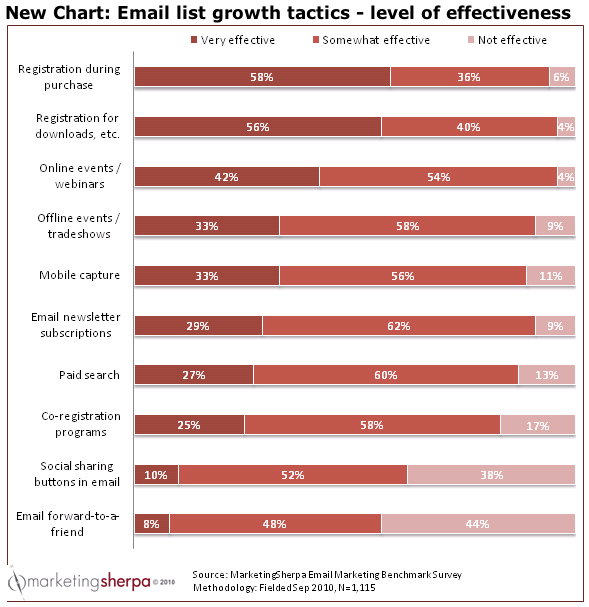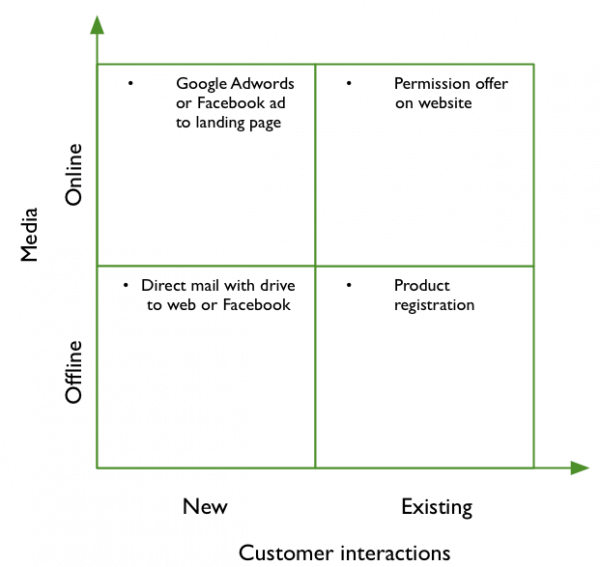15 techniques to grow your email subscribers
It's often easy to neglect your email list when there's a push to grow fans and followers on the social networks. But it's worth working on boosting email subscriptions too since email subscribers often have a strong level of trust in your content and brand. It's also easier to target them more easily with relevant offers based on their preferences and past behaviour. It’s often your email subscribers who convert to sale at a much higher rate than other sources of web traffic; they are most likely a significant segment of your buyers.
It makes sense to focus on getting sign-ups to an email list. "Traffic" is less useful unless you're confident of the source and that you can convert it, to something. Email traffic is a strong source of warm traffic.
Access Expert Member resource – Lead capture and audience profiling module
In this topic we’ll give you a structure to review and improve the types of insight you collect which will enable you to develop more relevant web and email personalisation to encourage conversion to sale.
Access the
We'll look at growing subscribers in two steps. First reviewing all the customer touchpoints when opt-in can occur and second ideas to boost opt-in. I hope these give you some ideas to review your approaches!
Update: Thanks to @tawatson alerting me to this update sharing research on the most popular ways to grow your email list from Marketing Sherpa, I have have added this chart to help you get new ideas to grow your list:
 Now onto my suggestions to help you find the best way to grow your list:
Now onto my suggestions to help you find the best way to grow your list:
Step 1. Review prospect and customer touchpoints
An approach that I’ve found is a good way to review all the possible methods of capturing e-mail addresses is for marketers to brainstorm alternative methods for capturing e-mail address by thinking about opportunities for capture which are:
- Online
- Offline
- Existing customers
- News customers
The matrix below can be used to generate ideas. 4 examples of different types of opportunities to capture e-mail addresses are shown.

Next we will consider online and offline opportunities for e-mail capture separately. Many of these apply equally to potential and existing customers.
Online opportunities for capture
Here are eight online methods to help build a house list.
- Direct from web site – permanent incentives to capture leads should be one of the main aims of a web presence, particularly for a B2B organisation. Design, structure and content should be devised to maximise conversion to sign-up.
- Web response from offline communications. Here an offer is publicised offline and respondents are referred to a web site to sign-up. (e.g. Dell offered a monthly notebook prize draw (www.dell.co.uk/winanotebook).
- Renting an e-mail list from a third party –recipients who click-through to a landing page are encouraged to opt-in to your house-list.
- Placing an ad in a third party e-newsletter. This has the same aims as 3, but may be more cost effective and can often be tightly targeted.
- Using a third party site, sometimes referred to as an ‘acquisition’ centre to provide offers with a view to sign-up.
- Campaigns with viral elements where a friend or colleague is referred can also increase the size of the house list. Here permission marketing and data protection law requires you to send an e-mail offering the referred person the option to opt-in before further communications are sent
- Any other forms of online traffic-building not mentioned above. Examples include graphical online ads or Pay Per Click text search engine ads)
- E-mail appending services. Less used now than previously, companies can be used to identify likely e-mail addresses from existing customers who have not yet supplied their address, e.g. John Smith at IBM is [email protected] (perhaps not the best example). Similar services can also attempt to correct e-mail addresses with typos.
Offline opportunities for capture
Offline opportunities are the full-range of customer touch-points. Here are eight more:
- Any form of paper registration or order form. But be sure to check the form of wording such that an opt-in to all forms of future communications is achieved.
- Visit from sales representatives. Can be used for opt-in either on paper, or through subscribing online.
- A phone contact at a call centre. For example a bank could ask customers whether they have an e-mail address during a routine phone enquiry.
- Telemarketing. This can be specifically to capture e-mail addresses, but is more cost-effective if it is part of a telemarketing campaign
- Point-of-sale. For a retail context.
- Trade show or conference. For example from a prize draw collecting business cards (but care with the opt-in).
- Paper response to a direct mail offer. Traditional direct response.
- Phone response to direct mail or ad. Again traditional direct response.
When e-mail addresses are captured offline a common problem is the level of errors in the address – this can often reach a double figure percentage. Plan for this also – staff should be trained in the importance of getting the e-mail address correct and how to check for an invalid address formats. Some call centres have even incentivised staff according to the number of valid e-mail addresses they collect. When collecting addresses on paper, some practical steps can help such as allowing sufficient space for the e-mail address and asking for it to be written in CAPS.
Step 2. Increasing email signup rates
So we have looked at reviewing different touchpoints for increasing signup. What about best practice to get more sign-up on these touchpoints? Here are our ideas to increase your email sign-up rate?
- Provide something of value. If you're focussing on a newsletter then ensure the content in it is remarkable and not just laden with offers! If you provide a service, offer something for free “white paper/ebook” download with your email sign-up. It can be as short as three pages or as long as 10-12 pages. If you are not a writer, then hire someone that is - that alone can make the difference between 5 and 50 sign-ups. If you provide a product then ensure regular great offers such as free shipping or a % off.
- Offer Social Proof. As Seth Godin notes, we all want to belong to groups, to tribes. When a person is on your blog or website and is thinking about handing over their email address, the first thing they are going to think about is whether they are alone in doing so. They require social proof. Your visitors need to see that other subscribers have validated their decision to join you and they want it in a range of ways. If you don’t have big subscriber numbers already then consider:
- Using testimonials in your sign up area. Why not show them what other people are saying about becoming a subscriber?
- Use exclusivity. Play to the tribe's benefits, "people like you", "our community of… "
- Use social media. Encourage the happy readers you already have to tweet your content, like it on Facebook - demonstrate that you’ve got good stuff.
- Ensure a compelling, findable sign-up. Is it at the top of your screen - “above the fold” – and on on important, high-traffic web pages? Remember not everyone comes to your site via your home page. Also, a direct call to action will usually converts better than a soft, vanilla flavoured one. It shouldn’t be in-your-face, yet it does need to instil confidence and simply ask the question.
- Offer a contest for monthly subscribers. So long as the prize is something that is relevant to your specific demographic then it'll have appeal, even better if it's something that is hard to get ordinarily. The aim is to ensure additional buzz above and beyond the quality of the content itself.
- Ensure sociable email. If they believe in you and your product or service, they will often be willing to spread the word. All you have to do is ask, and ideally ask that they forward to their friends emails and or social network. Tie this idea to number 3 above so create the incentive and inspiration to do so.
- Think guerrilla! Attracting email sign-up is not confined to your web page, consider natural places (touch-points) where a prospective or current customer may be interested in going online, especially with mobile in mind, to sign-up. Print newsletters, direct mail, email footers, brochures… there are a lot of touch-points. Ensure that you communicate what they are receiving in the newsletter - tips, offers, new releases, launches, prizes?
- Face objections. What kinds of experiences could cause turn a current or perspective subscriber off?
- Too many updates
- Poor relevance
- Email subscriptions that are complicated to unsubscribe from
- Concern that my email address will be sold to spammers


 Now onto my suggestions to help you find the best way to grow your list:
Now onto my suggestions to help you find the best way to grow your list:


